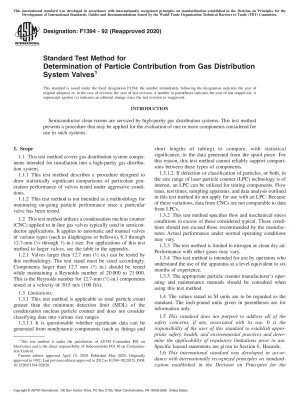ASTM F1394-92(2020)
Standard Test Method for Determination of Particle Contribution from Gas Distribution System Valves
- Standard No.
- ASTM F1394-92(2020)
- Release Date
- 2020
- Published By
- American Society for Testing and Materials (ASTM)
- Latest
- ASTM F1394-92(2020)
- Scope
- 1.1 This test method covers gas distribution system components intended for installation into a high-purity gas distribution system. 1.1.1 This test method describes a procedure designed to draw statistically significant comparisons of particulate generation performance of valves tested under aggressive conditions. 1.1.2 This test method is not intended as a methodology for monitoring on-going particle performance once a particular valve has been tested. 1.2 This test method utilizes a condensation nucleus counter (CNC) applied to in-line gas valves typically used in semiconductor applications. It applies to automatic and manual valves of various types (such as diaphragms or bellows), 6.3 through 12.7-mm (1⁄4 through 1⁄2-in.) size. For applications of this test method to larger valves, see the table in the appendix. 1.2.1 Valves larger than 12.7 mm (1⁄2 in.) can be tested by this methodology. The test stand must be sized accordingly. Components larger than 12.7 mm (1⁄2 in.) should be tested while maintaining a Reynolds number of 20 000 to 21 000. This is the Reynolds number for 12.7-mm (1⁄2-in.) components tested at a velocity of 30.5 m/s (100 ft/s). 1.3 Limitations: 1.3.1 This test method is applicable to total particle count greater than the minimum detection limit (MDL) of the condensation nucleus particle counter and does not consider classifying data into various size ranges. 1.3.1.1 It is questionable whether significant data can be generated from nondynamic components (such as fittings and short lengths of tubing) to compare, with statistical significance, to the data generated from the spool piece. For this reason, this test method cannot reliably support comparisons between these types of components. 1.3.1.2 If detection or classification of particles, or both, in the size range of laser particle counter (LPC) technology is of interest, an LPC can be utilized for testing components. Flow rates, test times, sampling apparatus, and data analysis outlined in this test method do not apply for use with an LPC. Because of these variations, data from CNCs are not comparable to data from LPCs. 1.3.2 This test method specifies flow and mechanical stress conditions in excess of those considered typical. These conditions should not exceed those recommended by the manufacturer. Actual performance under normal operating conditions may vary. 1.3.3 The test method is limited to nitrogen or clean dry air. Performance with other gases may vary. 1.3.4 This test method is intended for use by operators who understand the use of the apparatus at a level equivalent to six months of experience. 1.3.5 The appropriate particle counter manufacturer’s operating and maintenance manuals should be consulted when using this test method. 1.4 The values stated in SI units are to be regarded as the standard. The inch-pound units given in parentheses are for information only. 1.5 This standard does not purport to address all of the safety concerns, if any, associated with its use. It is the responsibility of the user of this standard to establish appropriate safety, health, and environmental practices and determine the applicability of regulatory limitations prior to use. Specific hazard statements are given in Section 6, Hazards. 1.6 This international standard was developed in accordance with internationally recognized principles on standardization established in the Decision on Principles for the 1 This test method is under the jurisdiction of ASTM Committee F01 on Electronics and is the direct responsibility of Subcommittee F01.10 on Contamination Control. Current edition approved April 15, 2020. Published May 2020. Originally approved in 1992. Last previous edition approved in 2012 as F1394–92(2012). DOI: 10.1520/F1394-92R20. Copyright © ASTM International, 100 Barr Harbor Drive, PO Box C700, West Conshohocken, PA 19428-2959. United States This international standard was developed in accordance with internationally recognized principles on standardization established in the Decision on Principles for the Development of International Standards, Guides and Recommendations issued by the World Trade Organization Technical Barriers to Trade (TBT) Committee. Development of International Standards, Guides and Recommendations issued by the World Trade Organization Technical Barriers to Trade (TBT) Committee.
ASTM F1394-92(2020) history
- 2020 ASTM F1394-92(2020) Standard Test Method for Determination of Particle Contribution from Gas Distribution System Valves
- 1992 ASTM F1394-92(2012) Standard Test Method for Determination of Particle Contribution from Gas Distribution System Valves
- 1992 ASTM F1394-92(2005) Standard Test Method for Determination of Particle Contribution from Gas Distribution System Valves
- 1992 ASTM F1394-92(1999) Standard Test Method for Determination of Particle Contribution from Gas Distribution System Valves
